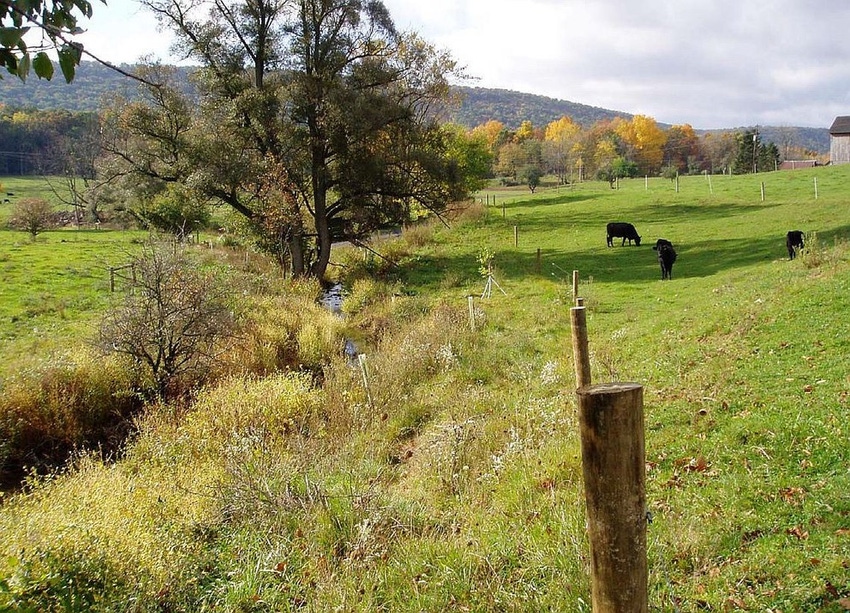Pennsylvania farmers aim to improve Chesapeake water quality
The cumulative numbers of conservation practices on the ground are significant and reveal a large amount of conservation being implemented by farmers outside of government cost-share programs.
December 19, 2016

Many Pennsylvania farmers in the Chesapeake Bay watershed have voluntarily implemented, at their own expense, practices aimed at improving water quality, according to newly released survey research conducted by Pennsylvania State University's College of Agricultural Sciences.
The study — built around a survey that nearly 7,000 farmers responded to — presents the first comprehensive inventory of farmers' voluntary use of water-quality best management practices. The study stemmed from agricultural leaders' desire to document measures Pennsylvania farmers have taken on their own, without federal or state funding, to reduce nitrogen and sediment levels in local streams, rivers and lakes.
The Pennsylvania Department of Environmental Protection (DEP), which funded the research along with Penn State, expressed interest in having the study done.
The study began with the Penn State Survey Research Center administering a survey in early 2016. A total of 6,782 farmers in 41 counties in the Chesapeake Bay watershed completed the survey, and researchers analyzed the responses. To verify response accuracy, researchers then randomly selected more than 700 of the respondents for farm visits in August by dozens of trained and experienced Penn State Extension staff.
Respondents reported implementing and covering the cost of the following water-quality best management practices:
* 475,800 acres of nutrient/manure management;
* 97,562 acres of enhanced nutrient management;
* 2,164 animal-waste storage units;
* 2,106 barnyard runoff-control systems;
* 55,073 acres of agricultural erosion and sedimentation control plans;
* 228,264 acres of conservation plans;
* More than 1.3 million linear feet of streambank fencing;
* 1,757 acres of grass riparian buffers, and
* 5,808 acres of forested riparian buffers.
The verification component of the survey confirmed that farmers were accurate in their reporting, according to Matthew Royer, director of the Penn State Agriculture & Environment Center, who oversaw the survey project.
"This survey is extremely valuable in reporting voluntary practices that, to date, have not been adequately captured and reported for credit," he said. "The cumulative numbers of conservation practices on the ground are significant and reveal a large amount of conservation being implemented by farmers outside of government cost-share programs. They have put a lot of their dollars and resources into conservation, so they should get credit for that."
Each year, DEP tracks agricultural conservation practices that are implemented to reduce pollution — many of which are government-funded and reported by state and federal agencies to the U.S. Environmental Protection Agency and the Chesapeake Bay Program Partnership to document Pennsylvania's progress toward improving local water quality and restoring the Chesapeake Bay. However, many Pennsylvania farmers want to ensure that the measures they install voluntarily, without state or federal cost-share, also are credited by the Chesapeake Bay Program Partnership.
Nevertheless, Royer said, "it doesn't mean that agriculture as a whole, or all farmers, have implemented what they need to meet water-quality goals — clearly more needs to be done."
The survey results were provided to DEP and presented Dec. 15 to the Chesapeake Bay Program's Agriculture Workgroup, which approved the survey process and was expected to recommend that EPA incorporate the results as part of this documentation and verification effort.
The survey was developed collaboratively by Penn State, Pennsylvania Farm Bureau, PennAg Industries Association, Pennsylvania Farmers Union, Pennsylvania Association for Sustainable Agriculture, Professional Dairy Managers of Pennsylvania, the Pennsylvania Department of Agriculture, the Pennsylvania State Conservation Commission, the Pennsylvania Association of Conservation Districts and DEP.
You May Also Like

.png?width=300&auto=webp&quality=80&disable=upscale)

